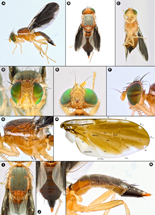Abstract
Hemilea hyalina Wang, 1998, previously known from China, is newly recorded from India. The first description of the female and detailed figures of habitus and genitalia are provided. The new records are also the first from outside the type locality.
References
- Cumming J. W. & Wood D. M. 2017. 3. Adult morphology and terminology, pp. 89–133. In: Manual of Afrotropical Diptera. Vol. 1. Introductory Chapters and Key to Diptera Families (A. H. Kirk-Spriggs and B. J. Sinclair, editors). Suricata 4, South African National Biodiversity Institute, Pretoria, i–xiii + 1–425.
- Das S. 1966. Palaearctic elements in the fauna of Kashmir. Nature 212: 1327–1330. https://doi.org/10.1038/2121327a0
- David K. J. & Ramani S. 2011. An illustrated key to fruit flies (Diptera: Tephritidae) from Peninsular India and the Andaman and Nicobar Islands. Zootaxa 3021(1): 1–31. https://doi.org/10.11646/zootaxa.3021.1.1
- David K. J., Hancock D. L., Sachin K. & Sankararaman H. 2020. A new species of Hemilea Loew and two new records of Trypetini (Diptera: Tephritidae: Trypetinae) from India. Zootaxa 4896(4): 571–576. https://doi.org/10.11646/zootaxa.4896.4.8
- David K. J., Ramani S. & Singh S. K. 2019. Taxonomy and diversity of Indian fruit flies (Diptera: Tephritidae), pp. 305–324. In: Indian Insects: Diversity and Science (S. Ramani, P. Mohanraj and H. Yeshwanth, editors). Boca Raton, CRC Press, 472. https://doi.org/10.1201/9780429061400-17
- Hadley A. 2024. Combine ZP software, new version. Available from: https://alan-hadley.software.informer.com/ (Accessed 15 Jan. 2024)
- Han H.-Y. 1999. Phylogeny and behavior of flies in the tribe Trypetini (Trypetinae), pp. 253–297. In: Fruit Flies (Tephritidae): Phylogeny and Evolution of Behavior (M. Aluja and A. L. Norrbom, editors). Boca Raton, CRC Press, 984. https://doi.org/10.1201/9781420074468.ch11
- Hancock D. L., Freidberg A. & Friedman A.-L.-L. 2021. Tephritidae. Chapter 71 (True fruit flies), pp. 1669−1734. In: Manual of Afrotropical Diptera. Vol. 3. Brachycera: Cyclorrhapha, excluding Calyptratae (A. H. Kirk-Spriggs and B. J. Sinclair, editors). Suricata. Vol. 8. South African National Biodiversity Institute, Pretoria, xv, 2379.
- Loew H. 1861. Ueber die afrikanischen Trypetina. Berliner Entomologische Zeitschrift 5: 253–306.
- Maqbool A., Akbar S. A. & Wachkoo A. A. 2023. First records of the genus Myathropa Rondani, 1845 (Diptera, Syrphidae) from India with new distributional and taxonomic notes for Myathropa semenovi (Smirnov, 1925). Journaal van Syrphidae 2(5): 1–9. https://doi.org/10.55710/1.LLJR4612
- Mir S. H., Ahmed S. B., Dar S. A. & Bano P. 2017. Hemilea malaisei Hering (Diptera: Tephritidae): the first record from India. Entomological News 127 (2): 151–153. https://doi.org/10.3157/021.127.0210
- Wang X.-J. 1998. The fruit flies (Diptera: Tephritidae) of the East Asian Region. Acta Zootaxonomica Sinica 21 (Supplement): i–viii + 1–338, 265 figs. & 41 pls.
- White I. M., Headrick D. H., Norrbom A. L. & Carroll L. E. 1999. Glossary, pp. 881–924. In: Fruit Flies (Tephritidae): Phylogeny and Evolution of Behavior (M. Aluja and A. L. Norrbom, editors). Boca Raton, CRC Press, 984. https://doi.org/10.1201/9781420074468
- Zhang Y., Hughes A. C., Zhao Z., Li Z. & Qin Y. 2022. Including climate change to predict the global suitable area of an invasive pest: Bactrocera correcta (Diptera: Tephritidae). Global Ecology and Conservation 34: e02021. https://doi.org/10.1016/j.gecco.2022.e02021


